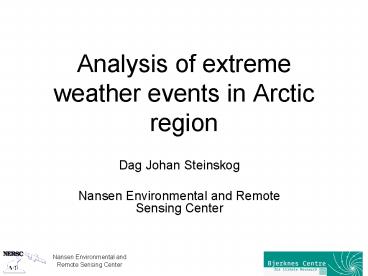Analysis of extreme weather events in Arctic region - PowerPoint PPT Presentation
1 / 21
Title:
Analysis of extreme weather events in Arctic region
Description:
Analysis of extreme weather events in Arctic region. Dag Johan Steinskog ... 'An extreme weather event is an event that is rare within its statistical ... – PowerPoint PPT presentation
Number of Views:44
Avg rating:3.0/5.0
Title: Analysis of extreme weather events in Arctic region
1
Analysis of extreme weather events in Arctic
region
- Dag Johan Steinskog
- Nansen Environmental and Remote Sensing Center
2
Introduction
- My motivation
- Identify and explain extremes in the Arctic
region in gridded datasets - Try to explain future changes in extremes and
explaining why using GCMs. - Why Arctic region?
- Impacts on ecosystems and humans
- Explaining results of global warming
- Fundamental understanding of high latitude climate
3
Extremes what is it?
- From a statistical perspective
- Unique technique develop models for describing
the unusual rather than the usual - Looking at the tails of a distribution rather
than the whole distribution - There is a need of enough data
- Both minimum and maximum extremes are possible to
look at (lower and upper tail)
4
Tail of a distribution
NASA Goddard Institute for Space Studies (GISS)
and Columbia University.
5
Two main techniques
- There are two main techniques for identifying
extremes in - extreme value analysis
- Generalized extreme value (GEV) family of extreme
distributions - Dividing the data into blocks
- Problem identifying size of blocks
- Generalized pareto distribution (GPD)
- Analysis of excesses of a given threshold
- Problem in which threshold to be selected
6
Methodology
- Three approaches on analysing extremes on
- gridded datasets
- Extreme value analysis of the grid points
- Coles (2001), Kotz and Nadarajah (2000) and
Beirlant et al. (2004) - Analysis of climate indices
- Easterling et al. (1997), Frich et al. (2002) etc
- Statistical testing (t-tests, goodness-of-fit
tests, etc)
7
Possible extremes in climate
- The extremes in climate are normally divided into
two - different groups (IPCC 2001)
- Simple extremes (single variable)
- Heavy rain- and snowfall
- Heat spell
- Cold spell
- Complex extremes (critical combination of several
variables) - Cyclone (rainfall and wind)
- Drought (little precipitation and high
temperatures)
8
(No Transcript)
9
Definitions of extremes in climate
- IPCC 2001 defintion of an extreme event
- An extreme weather event is an event that is
rare within its statistical refrence distribution
at a particular place. Definitions of rare
vary, but an extreme weather event would normally
be as rare or rarer than the 10th or 90th
percentile
10
Not the only definition.
- Other IPCC TAR 2001 definitions
- Extreme climate event
- An average of a number of weather events over a
certain period of time which itself extreme (e.g.
rainfall over a season) - Simple extremes
- Individual local weather variables exceeding
critical levels on a continuous scale
11
- Complex extremes
- Severe weather associated with particular
climatic - phenomena, often requiring a critical combination
of - variables
12
Scientific questions so far
- What is the spatial structure of extremes?
- How is the large scale flow connected/affecting
the extremes? - How is the over all static stability influence
extremes? - Sea ice extent and extremes?
- What about past and future trends?
13
Why are extremes interesting?
- Heat wave summer 2003 in Europe
- 14000 excess deaths estimated by French
authorities - ICRC World Disasters Report Ch. 2
- Heat waves in winter time in the Alps
- Economical problems because of lack of tourism in
ski resorts - Beniston (2005)
- The hurricane Katarina New Orleans
- Disaster that will probably cost several billions
USD and years to rebuild the city
14
The first experiments The spatial structure?
- Data NCEP/NCAR Reanalysis 6 hour mean
- Northern Hemisphere (20-90N, -180 180E)
- Any trends over ten days filtered out
- Ivar Seierstad lowpass filter
- Time period 1948-1953
- Season winter (120 days from October 1st)
- Threshold of 90-percentile of the data at each
gridpoint selected - Pareto distribution fitted to the tail.
15
(No Transcript)
16
(No Transcript)
17
Which factors are important for the creation of
extremes?
- Dynamical factors
- Pressure?
- Temperature gradients?
- Weather regimes
- NAO/AO?
- Scandinavian Pattern?
18
Connection to NAO?
- Beniston (2005) pointed out a possible connection
between NAO and heat waves in winter time in
Switzerland - Difference between the period 1901-1970 and
1970-2001 detected
19
Future climate?
- Warmer, wilder and wetter?
- There have been a significant decrease in the
number of of frost days and increases in the
number of very warm nights over much of the
Northern Hemisphere (Kiktev et al. 2003) - Will based on the results of the former questions
try to identify and look at extremes in future
(and past) climate - Climate models
- Variables Pressure and temperature
20
Summary
- Extremes in climate are of great interest.
- A statistical approach will provide useful
diagnostics about the extremes
21
References
- Stuart Coles (2001) An Introduction to
Statistical Modeling of Extreme Values - Samual Kotz and Saralees Nadarajah (2000)
Extreme Value Distributions Theory and
Applications - Jan Beirlant et al. (2004) Statistics in
Extremes Theory and applications - Beniston (2005)































